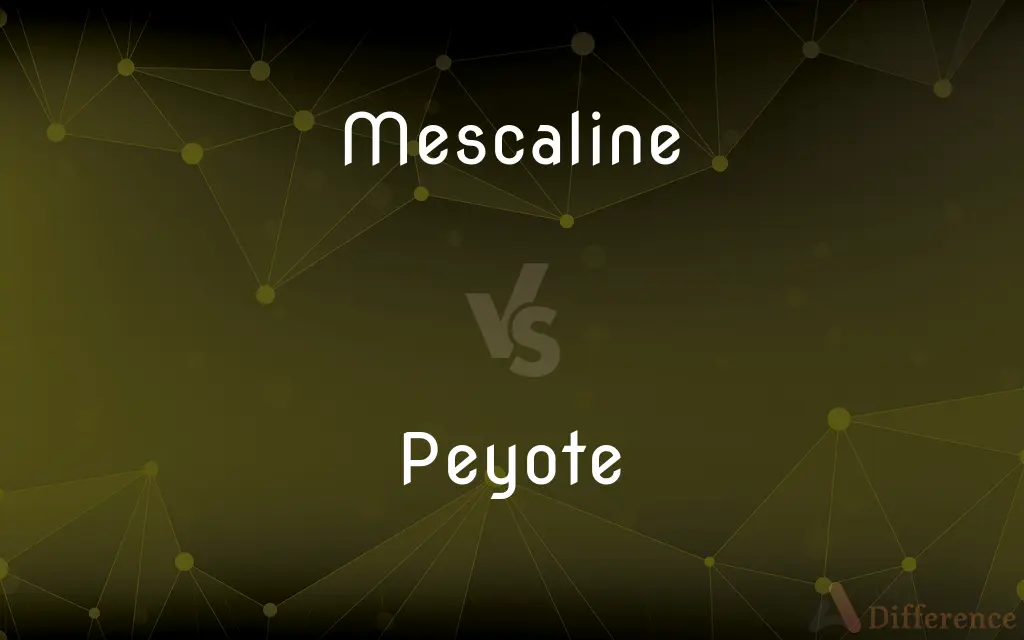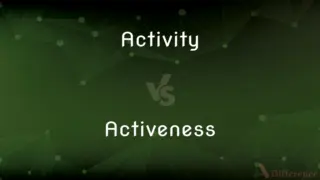Mescaline vs. Peyote — What's the Difference?
By Fiza Rafique & Urooj Arif — Updated on March 26, 2024
Mescaline is a psychoactive compound found in certain cacti, while Peyote is a small, spineless cactus containing mescaline.

Difference Between Mescaline and Peyote
Table of Contents
ADVERTISEMENT
Key Differences
Mescaline is a naturally occurring psychedelic alkaloid known for its hallucinogenic effects on the human mind, providing intense visual and altered states of consciousness. It is one of the oldest known psychedelics used by indigenous North American cultures for spiritual ceremonies. Whereas, Peyote (Lophophora williamsii) is a small, round cactus native to the deserts of Southern Texas and Mexico. It contains mescaline among other alkaloids, making it a powerful psychoactive plant. Peyote has been used for thousands of years in traditional spiritual rites by Native Americans, revered for its ability to induce visions and deep introspective states.
Mescaline can be extracted from several cactus species, including Peyote, the San Pedro cactus, and the Peruvian torch cactus. This makes mescaline a compound that can be isolated and used in a purified form. On the other hand, Peyote is used whole, with the small buttons (the fleshy part of the plant) being consumed directly or prepared into a tea for ceremonial use. This difference highlights the broader availability of mescaline through various sources versus the specific and culturally significant use of Peyote.
The effects of mescaline include altered states of consciousness, visual hallucinations, and profound changes in perception, mood, and thought. It can lead to intense experiences that vary significantly from person to person. In contrast, the use of Peyote, while also inducing similar effects due to its mescaline content, is often surrounded by a cultural and spiritual framework that guides the experience. This context can influence the interpretation and impact of the psychedelic journey.
Legally, mescaline is classified as a Schedule I controlled substance in the United States, indicating it has a high potential for abuse and no accepted medical use. Peyote, however, holds a unique legal status; it is exempt from Schedule I classification for members of the Native American Church for religious purposes. This distinction reflects societal recognition of Peyote's traditional and religious significance.
While both mescaline and Peyote offer pathways to profound psychological experiences, they are approached differently by users. Mescaline's use might be more experimental or recreational among psychedelic enthusiasts seeking its specific effects, while Peyote's use is deeply embedded in the spiritual and healing practices of certain indigenous cultures, emphasizing respect and sacredness.
ADVERTISEMENT
Comparison Chart
Definition
A psychedelic alkaloid.
A cactus that contains mescaline.
Source
Derived from various cacti.
Specifically comes from Lophophora williamsii.
Effects
Hallucinations, altered consciousness.
Similar effects, with cultural significance.
Usage
Isolated compound or synthesized.
Consumed whole or as tea in ceremonies.
Legal Status
Schedule I controlled substance.
Exemption for religious use by Native Americans.
Compare with Definitions
Mescaline
A hallucinogenic compound derived from certain cacti.
Scientists study mescaline for its potential therapeutic effects.
Peyote
Used primarily in Native American spiritual ceremonies.
The Native American Church uses peyote in their religious rites.
Mescaline
It is illegal in many countries due to its psychoactive effects.
Possessing mescaline without authorization can lead to legal consequences.
Peyote
Contains several alkaloids, including mescaline.
Peyote's psychoactive effects are primarily due to mescaline.
Mescaline
Has a long history of use in spiritual ceremonies.
Mescaline has been used by indigenous tribes for centuries in their rituals.
Peyote
Has a bitter taste when consumed.
The peyote buttons were bitter but revered for their spiritual significance.
Mescaline
Can alter time perception and thought processes.
Time seemed to slow down for him after taking mescaline.
Peyote
Protected under U.S. law for religious use by certain groups.
Native Americans legally use peyote in their ceremonies.
Mescaline
Known for inducing vivid visual hallucinations.
Users report seeing intricate patterns while under the influence of mescaline.
Peyote
A small, spineless cactus with psychoactive properties.
He cultivated peyote for personal spiritual practices.
Mescaline
Mescaline (3,4,5-trimethoxyphenethylamine) is a naturally occurring psychedelic protoalkaloid of the substituted phenethylamine class, known for its hallucinogenic effects comparable to those of LSD and psilocybin. It occurs naturally in the San Pedro cactus (Trichocereus (Echinopsis) pachanoi), the Peruvian torch (Trichocereus peruvianus (Echinopsis peruviana)), the Bolivian torch cactus (Echinopsis lageniformis), the peyote cactus (Lophophora williamsii), and other species of cacti.
Peyote
The peyote (; Lophophora williamsii ) is a small, spineless cactus which contains psychoactive alkaloids, particularly mescaline. Peyote is a Spanish word derived from the Nahuatl peyōtl ([ˈpejoːt͡ɬ]), meaning "caterpillar cocoon", from a root peyōni, "to glisten".
Mescaline
A hallucinogenic alkaloid, C11H17NO3, obtained from peyote buttons and used by certain Native American tribes in religious rituals and illicitly as a recreational drug.
Peyote
A spineless, dome-shaped cactus (Lophophora williamsii) native to Mexico and the southwest United States, having buttonlike tubercles that contain the hallucinogen mescaline and are traditionally used in rituals by certain Native American peoples. Also called mescal.
Mescaline
(biochemistry) A hallucinogenic and intoxicating compound present in the peyote cactus (Lophophora williamsii), the San Pedro cactus (Echinopsis pachanoi), and the Peruvian torch (Echinopsis peruviana).
Peyote
Peyote buttons.
Mescaline
The hallucinatory alkaloid that is the active agent in mescal buttons
Peyote
A small, spineless cactus (Lophophora williamsii) found from southwest United States to central Mexico that produces buttonlike tubercles that can be chewed for its psychedelic effect, primarily from the drug mescaline.
Peyote
A mescal button produced by the plant.
Peyote
A small spineless globe-shaped cactus; source of mescal buttons
Peyote
The hallucinatory alkaloid that is the active agent in mescal buttons
Common Curiosities
How is mescaline used?
Mescaline can be consumed in its natural form from cacti like Peyote or synthesized and taken as a pure compound.
Why is Peyote significant in Native American culture?
Peyote is integral to Native American spiritual practices, providing visions and insights during religious ceremonies.
Are mescaline and Peyote legal?
Mescaline is a Schedule I controlled substance, but Peyote is legally used by members of the Native American Church for religious purposes in the U.S.
What is mescaline?
Mescaline is a psychoactive alkaloid found in certain cactus species, known for inducing hallucinations and altered states of consciousness.
How is Peyote consumed?
Peyote can be eaten whole, dried and chewed, or brewed into a tea for consumption.
Can mescaline be found in plants other than Peyote?
Yes, mescaline can also be extracted from the San Pedro cactus and the Peruvian torch cactus, among others.
How does mescaline affect the brain?
Mescaline binds to serotonin receptors, leading to altered perceptions, emotions, and visual hallucinations.
What is Peyote?
Peyote is a small, spineless cactus containing mescaline, used for centuries in Native American spiritual ceremonies.
Is there a difference in the experience between mescaline and Peyote?
The psychoactive effects are similar, but the cultural and spiritual context of Peyote use can influence the experience.
What are the effects of mescaline?
Effects include visual hallucinations, altered perception of time and space, and profound introspective experiences.
Can mescaline be used for therapeutic purposes?
Research into mescaline's therapeutic potential is ongoing, with some studies suggesting benefits for mental health conditions.
What is the legal status of mescaline in other countries?
The legal status of mescaline varies, with many countries classifying it as an illegal substance due to its psychoactive properties.
Can anyone grow Peyote?
Legality of growing Peyote depends on local laws, with restrictions in place in many areas due to its psychoactive alkaloids.
What role does Peyote play in modern medicine?
While not officially recognized in modern medicine, Peyote's potential therapeutic benefits are subject of ongoing research.
How long have people been using Peyote?
Indigenous North Americans have used Peyote in spiritual practices for thousands of years.
Share Your Discovery

Previous Comparison
Activity vs. Activeness
Next Comparison
Dodecahedron vs. IcosahedronAuthor Spotlight
Written by
Fiza RafiqueFiza Rafique is a skilled content writer at AskDifference.com, where she meticulously refines and enhances written pieces. Drawing from her vast editorial expertise, Fiza ensures clarity, accuracy, and precision in every article. Passionate about language, she continually seeks to elevate the quality of content for readers worldwide.
Co-written by
Urooj ArifUrooj is a skilled content writer at Ask Difference, known for her exceptional ability to simplify complex topics into engaging and informative content. With a passion for research and a flair for clear, concise writing, she consistently delivers articles that resonate with our diverse audience.
















































